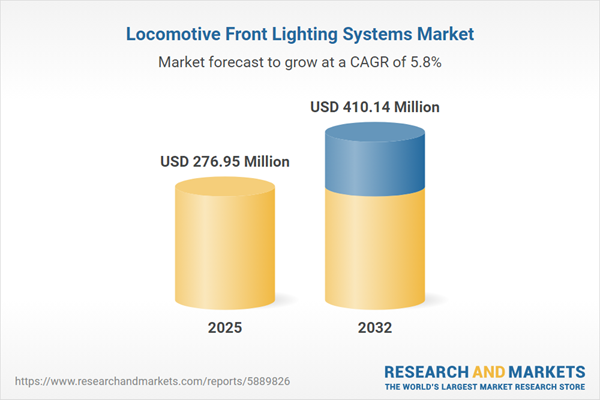Speak directly to the analyst to clarify any post sales queries you may have.
The locomotive front lighting systems market is rapidly evolving as rail industry leaders strive to enhance safety, meet regulatory requirements, and drive operational efficiency. Senior decision-makers are adopting advanced lighting technologies to maximize asset performance and respond to increasingly complex industry standards.
Market Snapshot: Locomotive Front Lighting Systems Market
The locomotive front lighting systems market expanded from USD 261.48 million in 2024 to USD 276.95 million in 2025, reflecting a compound annual growth rate (CAGR) of 5.78%. This upward trend is influenced by robust modernization initiatives in both passenger and freight rail segments. Operators are investing in new lighting systems to boost rail safety, improve night-time and adverse weather visibility, and ensure reliable service continuity. Heightened adoption of front lighting technology supports compliance efforts and strengthens fleet management. Regions across the Americas, Europe, Middle East & Africa, and Asia-Pacific continue to prioritize quality lighting solutions to meet changing regulatory and operational criteria.
Scope & Segmentation
- Light Source Types: Incandescent halogen, sealed beam, high-intensity discharge (metal halide and xenon), and LED lights are adopted for both fleet expansion and modernization projects. The shift towards LED technology is notable for its lower energy consumption, minimal maintenance, and optimal asset utilization.
- Locomotive Types: Solutions address requirements for heavy freight, high-speed passenger, regional service, shunting, and industrial locomotives, taking into account diverse operational and regulatory needs across segments.
- Installation Types: Fleet operators benefit from aftermarket retrofits, direct component replacement, and factory OEM installation, allowing phased modernization with reduced disruption to workflows.
- Mounting Positions: Nose-mounted and top-of-cab assemblies are designed to support different signaling protocols and environmental conditions, aiding in compliance across regions with unique safety regulations.
- Sales Channels: Direct purchases from OEMs, dealings with recognized dealers, and distributor partnerships ensure comprehensive access to new lighting systems and essential spare parts for ongoing reliability.
- Geographical Coverage: Distinct adoption patterns exist in the Americas, Europe, the Middle East & Africa, and Asia-Pacific, influenced by local regulations, funding cycles, and environmental factors that shape the pace of technology adoption.
- Company Coverage: Key manufacturers include CRRC Corporation Limited, Siemens Mobility GmbH, Alstom SA, Wabtec Corporation, Hitachi Rail Ltd., Hyundai Rotem Company, Stadler Rail AG, CAF, PESA Bydgoszcz S.A., and Toshiba Infrastructure Systems & Solutions Corp., each contributing to industry advancements through innovation and collaborative partnerships.
Key Takeaways
- LED-based systems are delivering measurable savings and improved reliability by reducing both energy usage and ongoing maintenance requirements, particularly vital for operators managing large and diverse fleets.
- New smart beam control and adaptive sensor technologies enhance real-time lighting responses, supporting driver visibility and overall alignment with modern safety imperatives in passenger and freight operations.
- Flexible system designs allow procurement teams to customize lighting solutions to fit local and regional specifications, providing resilience against operational challenges posed by climate extremes or shifting compliance needs.
- Closer collaboration between original equipment manufacturers and aftermarket experts expands access to modular retrofit kits, facilitating rapid upgrades and supporting seamless operations within mixed-fleet environments.
- Adopting a phased, strategic approach to fleet upgrades via retrofit programs enables organizations to incrementally boost safety while balancing capital outlays and minimizing service interruptions.
Tariff Impact
The introduction of 2025 US tariffs has driven up costs for essential materials and components, prompting manufacturers and rail operators to reassess sourcing models. Companies are actively diversifying suppliers and pursuing supply chain efficiencies to uphold compliance and reduce overall operational risk.
Methodology & Data Sources
This market analysis is informed by executive interviews, on-site facility assessments, patent data reviews, and full value-chain evaluations. Targeted secondary research and peer reviews reinforce insights critical for organizations seeking guidance on fleet modernization or regulatory alignment.
Why This Report Matters
- Empowers executives with actionable intelligence to navigate changing regulatory obligations while optimizing procurement and technology deployment.
- Clarifies key trends in regional investments to support strategic decisions in asset modernization and long-term fleet management.
- Offers leadership teams solutions to accelerate upgrades without jeopardizing ongoing rail service or compromising safety standards.
Conclusion
With modular lighting and intelligent control platforms now central to rail asset strategies, this report supports decision-makers in strengthening compliance, operational efficiency, and focused modernization activities within a competitive and regulated industry landscape.
Additional Product Information:
- Purchase of this report includes 1 year online access with quarterly updates.
- This report can be updated on request. Please contact our Customer Experience team using the Ask a Question widget on our website.
Table of Contents
3. Executive Summary
4. Market Overview
7. Cumulative Impact of Artificial Intelligence 2025
Companies Mentioned
The companies profiled in this Locomotive Front Lighting Systems market report include:- CRRC Corporation Limited
- Siemens Mobility GmbH
- Alstom SA
- Wabtec Corporation
- Hitachi Rail Ltd.
- Hyundai Rotem Company
- Stadler Rail AG
- CAF – Construcciones y Auxiliar de Ferrocarriles, S.A.
- PESA Bydgoszcz S.A.
- Toshiba Infrastructure Systems & Solutions Corp.
Table Information
| Report Attribute | Details |
|---|---|
| No. of Pages | 190 |
| Published | November 2025 |
| Forecast Period | 2025 - 2032 |
| Estimated Market Value ( USD | $ 276.95 Million |
| Forecasted Market Value ( USD | $ 410.14 Million |
| Compound Annual Growth Rate | 5.7% |
| Regions Covered | Global |
| No. of Companies Mentioned | 11 |









